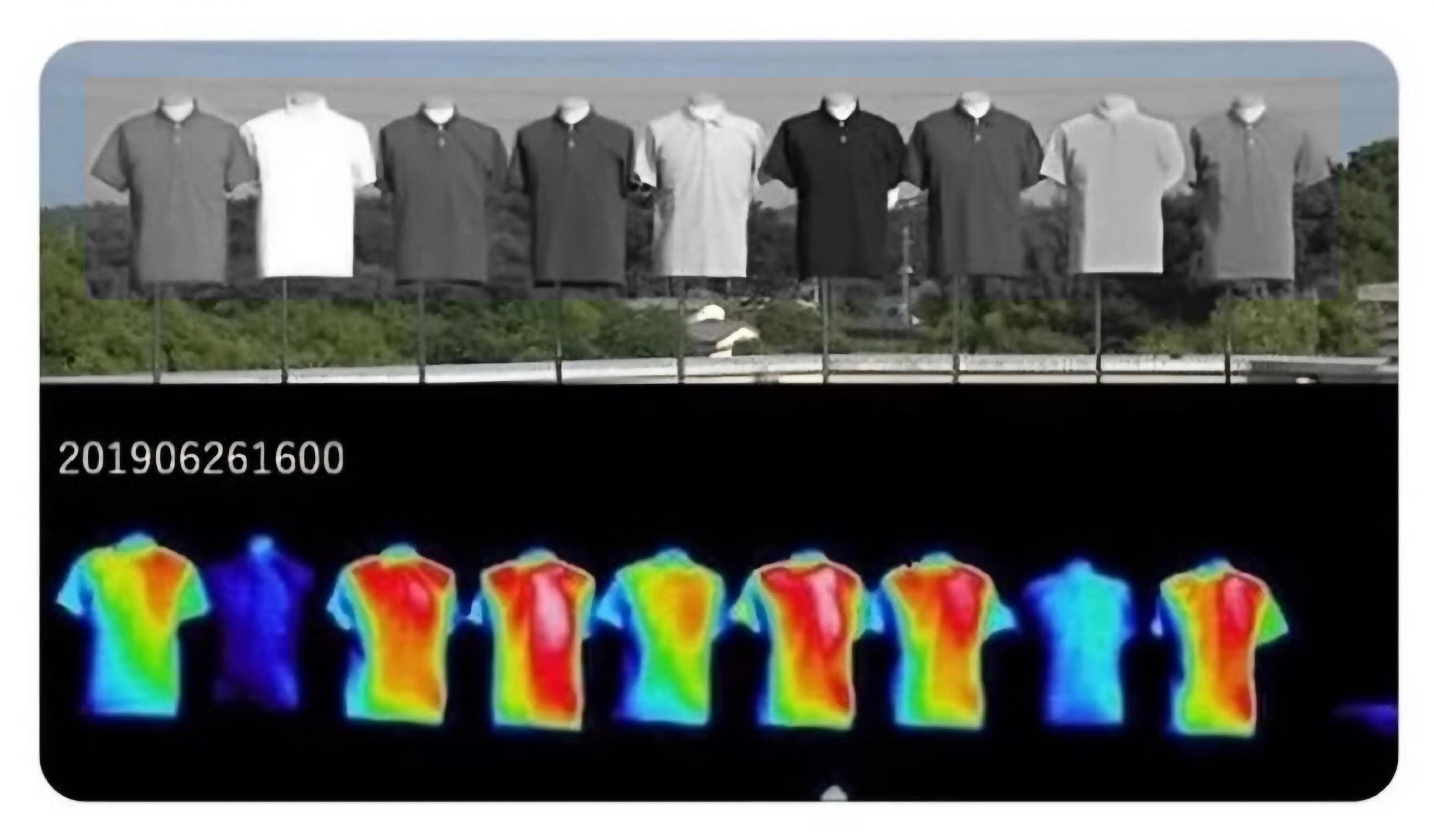I just see that all colors turn into pride colors in the sun
Sun turns us gay!
Is there any way to tell the difference between infrared reflected between (I assume) 8 and 13 microns and the infrared emitted due to absorption of shorter wavelengths?
Just get some loose linnen button down shirts, they are fantastic
That’s not exactly heat absorbtion though. Infrared cameras capture the heat radiated by the shirts and black color is the one that radiates heat the best. That’s why matt black is the worst color for a thermos and chrome is the best.
If they have identical or close enough emissivity it is directly proportional to heat absorption, as given identical amounts of time in the sun and air flow, temperature will almost entirely depend in absorptivity, and emitted infrared is proportional to temperature^4.
Black bodies emit and absorb perfectly. These probably all have an emissivity that’s lower than a blackbody, and very close together, while absorptivity is related to the color of the shirt. So this test is actually fairly indicative.
my friends make fun of me for wearing black in the summertime but i am more uncomfortable wearing non-black than i am just sweating it out 🫠
Also a good indicator of why must plants use chlorophyll, which primarily reflect green light in our planet’s biosphere.
So does black make a significant difference when it’s colder? Or is it only noticable when there’s harsh sun?
It’s different: radiation of long-wave infrared balanced against absorption of ambient light.
As someone who grew up in northern areas, not really. In fall or spring (Oct, or April) when the sun has a better angle you can notice. But the rest of the winter when the sun’s at a slant? Not so much.
Body puts off heat too. White reflects it back, black lets it escape.
Google says : colors do not absorb different amounts of heat, only heat from light.
Google also says to put glue on your pizza.
I mean some people put pineapple on it
Body emits infrared radiation. Sun does too. They make foil-lined jackets to reflect this heat. White shirts do it too, as shown in the image.
Not according to science articles on the web. infrared penetrates regardless of colour, visible light spectrum capturea or reflects the rest.
It depends on the absorptivity of the pigment at that given wavelength. Foil for example works because in ye infrared it is still reflective. Without an infrared camera and an infrared light it’s impossible to tell what the infrared absorptivity of a given shirt is by eye. The science articles are not giving the full picture.
It seems it’s still an active debate and area of research, but the answer is more complex than wavelengths and emissivity. If you want to know whether black or white is cooler in the sun, it depends on: the breathability or knit, the amount of UV hitting the skin, the amount of skin contact with the fabric, wind speed, relative humidity, how the fabric wets and wicks moisture, and more. We could look at a black trash bag and say, well it’s transparent to IR, and it blocks the visible spectrum, therefore it’s a good shirt material to keep one cool. And obviously that would be wrong. In the same way it’s wrong to say: a white shirt feels less hot when you touch it, therefore it keeps the wearer cooler.
Yes, all of that is obviously true between shirts, the question is about shirt color, which is almost entirely down to the pigments used in fabrication. In which case it is entirely due to the absorptivity, emissivity, reflectance, and opacity, of the pigment.
This isn’t an active area of debate, it’s an entirely empirical question or a hard modeling problem per shirt manufacturer. All of this is very solved science, and has become “an engineering problem”

Dang green, you hot!
Also, grey… you have betrayed us.
How is a light gray that much warmer than yellow? Seems suspicious 🤔
I guess gray is just black and white mixed, and black does not do very well
Yellow also reflects a tonne of UV and IR light. Probably helps make it so much more visible to everything than other colors
I still can’t get myself to wear a white T-shirt despite me wanting it.
My sweat will ruin any white fabric after the first or second wear.
Do you use aluminum/antiperspirants? I think that is what causes the staining.
yup, the aluminum basically acts as a mordant for the natural yellowish stain of sweat and its microbial metabolites
best to skip antiperspirant when wearing white shirts. aluminum-free deodorant (there is no such thing as aluminum free antiperspirant, btw) can help mask BO but will not stop sweat. but if you like white shirts that’s probably a decent trade-off.
zinc oxide is a decent deodorant ingredient that doesn’t prevent sweating but does slow down microbes that eat sweat and release odorous compounds
avoid baking soda if you have sensitive skin as it can raise your skin pH to uncomfortable levels. ymmv
who would have guessed?
Well a dog. Could guess it I mean.
If dogs can guess things, which I don’t even know if they can. But maybe.
I think maybe a dog could guess it.
What about sequined shirts? If I get the right angle I can boil a cup of water within seconds while staying cool inside. For an extra barrier I wrap my body in foil, keeps the 5g out as a bonus.
So white and yellow for staying cool, every other color heats up.
Its a bit misleading. Black clothes will absorb the heat from the sun and your body and then the clothes will cool via convection. So the wind blowing through the clothes takes the heat away. White will reflect the heat from the sun away and your body back towards you.
Im sure theres some debate and probably way more to it but i have always felt more comfortable in the heat than other people and i wear darker clothes the majority of the time. If that anecdote bares any weight.
Google says : colors do not absorb different amounts of heat, only heat from light.
Heat from light isn’t heat?
Tradeoff is dark colors absorb more UV so it provides better protection from the sun
Umm…
Reflection is just as effective as absorption. As long as the UV isn’t passing through the fabric into you, you are fine.
Look at the sun through a white shirt, then black. Which is brighter?
Gotta get that UV colored tshirt :-)
FYI there are UV absorbant tshirts, crazily practic for kids.
Skincancer.org is my source for darker colors being better protection
I don’t have the highest degree of confidence in it but it makes sense to me that absorption matters more than reflection because a lot of the reflected UV will be going through the shirt and onto your skin
That’s why materials like linen aren’t as good for UV protection. They’re light weaves and let a lot of light through, still
Red looks surprisingly effective as well.












